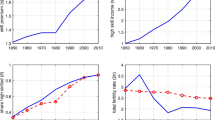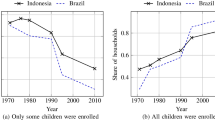Abstract
We study differential fertility and intergenerational mobility in an overlapping-generations framework with skilled and unskilled individuals. Assuming unskilled parents are less productive in educating children, we show that they choose higher fertility but less investment for child education than skilled parents. Public education reduces the fertility gap but may increase intergenerational mobility under certain conditions. We also find very different responses of fertility differential and intergenerational mobility to a variation in a preference or technology parameter. As the ratio of skilled to working population rises towards its steady state, average income rises, average fertility falls, but income inequality first rises and then falls.


Similar content being viewed by others
Notes
A very partial list of this literature includes, for example, Becker and Tomes (1979), Loury (1981), Piketty (1995), Galor and Tsiddon (1997), Owen and Weil (1998), Iyigun (1999), Maoz and Moav (1999), Mookherjee and Ray (2003), Davies et al. (2005), Cremer and Pestieau (2006), and Docquier et al. (2007). Moreover, see Piketty (2000) for a survey of this literature.
There is already a large literature on “endogenous fertility,” which explains the negative correlation between parental education (or income) and fertility from different angles. The model developed in this section is most closely related to and different from de la Croix and Doepke (2004). Our model implies a negative correlation between parental education and fertility under both private and public educational systems, while their model implies the same fertility for all individuals, skilled or unskilled alike, under public education in which everyone receives the same amount of educational expenditure.
Making this assumption is a simple yet relevant way to capture the stylized fact that better educated parents spend more time in the education of each child according to the empirical evidence in the literature of both sociology and economics (e.g., Ballantine 2001, Weinberg 2001, and Ramey and Ramey 2010).
The importance of family background, and particularly of parental academic achievements and human capital, for an individual’s educational attainment has been consistently confirmed in the empirical literature; see Becker (1991) and de la Croix and Michel (2002) for useful surveys, and a more recent empirical study by Anger and Heineck (2010).
For some related existing models, see Galor and Tsiddon (1996) and the literature surveyed wherein. In those articles, yet, the economic forces underlying the result resembling the Kuznets curve are different from the one in action here. Specifically, in the previous literature, the curve emerges because of technological progress, which is not the case here.
A further comment is that this result may be related to our simplifying assumption that public education cannot be complemented by private investment. The results may be modified if this assumption is relaxed, and de la Croix and Doepke (2009) provide a framework for such a possible extension.
Note that in this paper, the wage rates for skilled and unskilled are fixed. Thus, both the average output and the average utility only depend on the proportion of skilled individuals.
In this section, for simplicity, we do not conduct the analysis of social welfare, which would be qualitatively similar to that in Section 6.
References
Anger S, Heineck G (2010) Do smart parents raise smart children? The intergenerational transmission of cognitive abilities. J Popul Econ 23(3):1105–1132
Ballantine JH (2001) The sociology of education: a systematic analysis. Prentice-Hall, Upper Saddle River, NJ
Barro RJ, Sala-i-Martin X (1992) Convergence. J Polit Econ 100(2):223–251
Becker GS (1991) A treatise of the family. Harvard University Press, Cambridge, MA
Becker G, Lewis HG (1973) On the interaction between the quantity and quality of children. J Polit Econ 81(2):S279-S288
Becker G, Tomes N (1979) An equilibrium theory of the distribution of income and intergenerational mobility. J Polit Econ 87(6):1153–1189
Benabou R (1996) Heterogeneity, stratification, and growth: macroeconomic implications of community structure and school finance. Am Econ Rev 86(3):584–609
Behrman JR, Foster AD, Rosenzweig MR, Vashishtha P (1999) Women’s schooling, home teaching, and economic growth. J Polit Econ 107(4):682–714
Booth AL, Kee HJ (2009) Birth order matters: the effect of family size and birth order on educational attainment. J Popul Econ 22(2):367–397
Cardak BA (2005) Education vouchers, growth, and income inequality. Macroecon Dyn 9(1):98–121
Cremer H, Pestieau P (2006) Intergenerational transfer of human capital and optimal education policy. J Public Econ Theory 8(4):529–545
Cremer H, Gahvari F, Pestieau P (2006) Pensions with endogenous and stochastic fertility. J Public Econ 90(12):2303–2321
Cremer H, Gahvari F, Pestieau P (2011) Fertility, human capital accumulation, and the pension system. J Public Econ 95(11–12):1272–1279
de la Croix D, Doepke M (2003) Inequality and growth: why differential fertility matters. Am Econ Rev 93(4):1091–1113
de la Croix D, Doepke M (2004) Public versus private education when differential fertility matters. J Dev Econ 73(2):607–629
de la Croix D, Doepke M (2009) To segregate or to integrate: education politics and democracy. Rev Econ Stud 76(2):597–628
de la Croix D, Michel P (2002) A theory of economic growth: dynamics and policy in overlapping generations. Cambridge University Press, Cambridge, UK
Davies JB, Zhang J, Zeng J (2005) Intergenerational mobility under private vs public education. Scand J Econ 107(3):399–417
Docquier F, Paddison O, Pestieau P (2007) Optimal accumulation in an endogenous growth setting with human capital. J Econ Theory 134(1):361–378
Ehrlich I, Lui FT (1991) Intergenerational trade, longevity, and economic growth. J Polit Econ 99(5):1029–1060
Epple D, Romano RE (1998) Competition between private and public schools, vouchers, and peer-group effects. Am Econ Rev 88(1):33–62
Fan CS, Stark O (2008) Looking at the “population problem” through the prism of heterogeneity: welfare and policy analyses. Int Econ Rev 49(3):799–835
Fernandez R, Rogerson R (2003) Equity and resources: an analysis of education finance systems. J Polit Econ 111(4):858–897
Galor O (2005) From stagnation to growth: unified growth theory. In: Aghion P, Durlauf SN (eds) Handbook of economic growth. Elsevier, Amsterdam, pp 171–293
Galor O, Moav O (2002) Natural selection and the origin of economic growth. Q J Econ 117(4):1133–1192
Galor O, Moav O (2004) From physical to human capital accumulation: inequality and the process of development. Rev Econ Stud 71(4):1001–1026
Galor O, Moav O (2006) Das human-capital: a theory of the demise of the class structure. Rev Econ Stud 73(1):85-117
Galor O, Tsiddon D (1996) Income distribution and growth: the Kuznets hypothesis revisited. Economica 63(250):S103–S117
Galor O, Tsiddon D (1997) Technological progress, mobility, and economic growth. Am Econ Rev 87(3):363–382
Galor O, Weil DN (2000) Population, technology, and growth: from Malthusian stagnation to the demographic transition and beyond. Am Econ Rev 90(4):806–828
Galor O, Zeira J (1993) Income distribution and macroeconomics. Rev Econ Stud 60(1):35–52
Glomm G, Ravikumar B (1992) Public versus private investment in human capital: endogenous growth and income inequality. J Polit Econ 100(4):818–834
Glomm G, Ravikumar B (2003) Public education and income inequality. Eur J Polit Econ 19(2):289–300
Grawe ND, Mulligan CB (2002) Economic interpretations of intergenerational correlations. J Econ Perspect 16(3):45–58
Hassler J, Mora JVR (2000) Intelligence, social mobility, and growth. Am Econ Rev 90(4):888–908
Hazan M, Berdugo B (2002) Child labour, fertility, and economic growth. Econ J 112(483):810–828
Iyigun MF (1999) Public education and intergenerational economic mobility. Int Econ Rev 40(3):697–710
Lindquist MJ, Lindquist GS (2011) The dynamics of child poverty in Sweden. J Popul Econ 25(4):1423–1450
Loury GC (1981) Intergenerational transfers and the distribution of earnings. Econometrica 49(4):843–867
Lynch LM (2000) Trends and consequences of investment in children. In: Waldfogel J, Danziger S (eds) Securing the future, the Ford foundation series on asset building. Russell Sage Foundation, New York, pp 19–46
Maoz YD, Moav O (1999) Intergenerational mobility and the process of development. Econ J 109(458):677–697
Moav O (2005) Cheap children and the persistence of poverty. Econ J 115(500):88–110
Mookherjee D, Napel S (2007) Intergenerational mobility and macroeconomic history dependence. J Econ Theory 137(1):49–78
Mookherjee D, Ray D (2003) Persistent inequality. Rev Econ Stud 70(2):369–393
Owen AL, Weil DN (1998) Intergenerational earnings mobility, inequality and growth. J Monet Econ 41(1):71–104
Piketty T (1995) Social mobility and redistributive politics. Q J Econ 110(3):551–584
Piketty T (2000) Theories of persistent inequality and intergenerational mobility. In: Atkinson AB, Bourguignon F (eds) Handbook of income distribution, vol 1. Elsevier, Amsterdam, pp 429–476
Ramey G, Ramey VA (2010) The rug rat race. Brookings Pap Econ Act 41(1):129–176
Razin A, Sadka E (1995) Population economics. MIT Press, Cambridge, MA
Riphahn RT, Schieferdecker F (2011) The transition to tertiary education and parental background over time. J Popul Econ 25(2):635–675
Solon G (2002) Cross-country determinants in intergenerational earnings mobility. J Econ Perspect 16(3):59–66
Varvarigos D, Zakaria IZ (2012) Endogenous fertility in a growth model with public and private health expenditures. J Popul Econ. doi:10.1007/s00148-012-0412-1
Weinberg BA (2001) An incentive model of the effect of parental income on children. J Polit Econ 109(2):266–280
Wilson D, Burgess S, Briggs A (2011) The dynamics of school attainment of England’s ethnic minorities. J Popul Econ 24(2):681–700
Zhang J (1996) Optimal public investments in education, and endogenous growth. Scand J Econ 98(3):387–404
Zhang J, Zhang J, Lee R (2001) Mortality decline and long-run economic growth. J Public Econ 80(3):485–507
Acknowledgements
We are grateful to two anonymous referees for constructive comments and suggestions, which improved the paper significantly. The research is financed by the National University of Singapore (grant # R122000117).
Author information
Authors and Affiliations
Corresponding author
Additional information
Responsible editor: Junsen Zhang
Electronic Supplementary Material
Rights and permissions
About this article
Cite this article
Fan, C.S., Zhang, J. Differential fertility and intergenerational mobility under private versus public education. J Popul Econ 26, 907–941 (2013). https://doi.org/10.1007/s00148-012-0445-5
Received:
Accepted:
Published:
Issue Date:
DOI: https://doi.org/10.1007/s00148-012-0445-5




